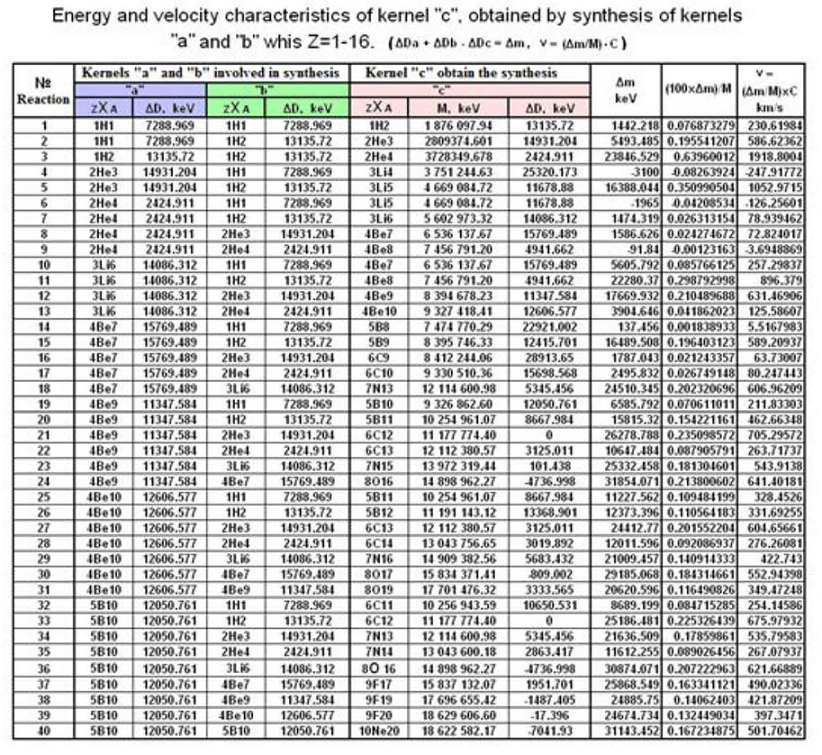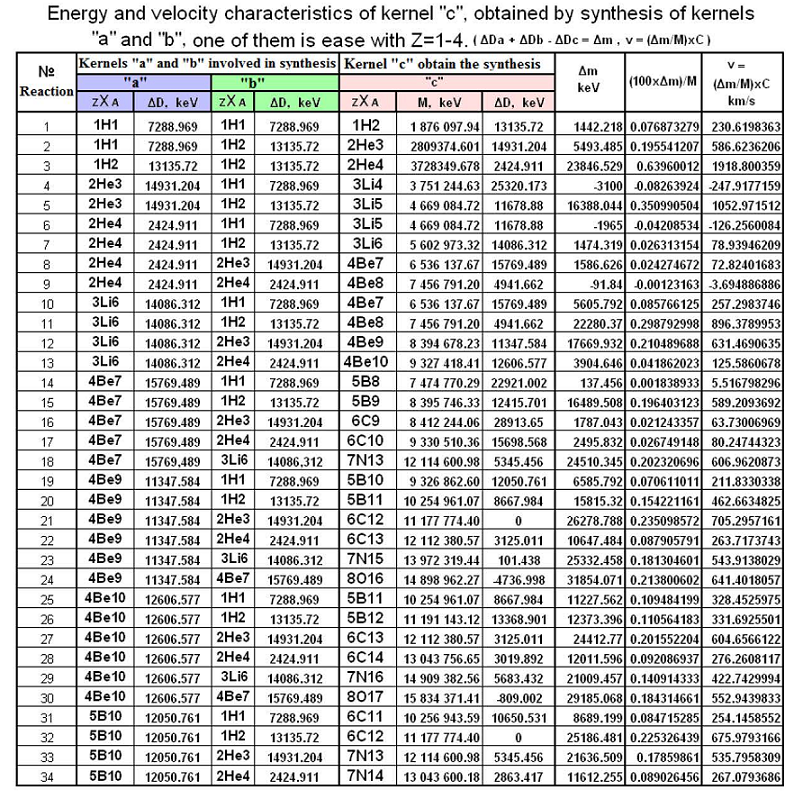In order to confirm our version, it is necessary to catch isotopes that are part of «the solar wind» with time of a life a little longer than the time of flight of the space vehicle and the manufacture of chemical analysis of the received material.
These isotopes should not be as easy as hydrogen +1Н with A=3, with half-life period
Т1/2= 12.3 years, since the given isotope has a high probability to fly from a kernel of a star to the top layers of the atmosphere and to reach a point of picking the space vehicle, and to survive until the chemical analysis.
Also, isotopes should not have too short half-life period since it is possible to assume, that the kernels have been born at the moment of «the big explosion» and have got in a star structure during the process of its formation (though billions years have passed since «the big explosion»).
That means, the half-life period or time of life of an isotope should lie between several days to several years and to several decades.
Roughly, it is such isotopes as: H3; Ве7; Na22; Si32; Ar39; Ar42; Ti44; Ni63 and so on. We see that such isotopes are around 10-15 from the 604 variants shown in table №A-2.
The probability of detection of such isotopes in «the solar wind» makes less than 0.05%, provided that during the synthesis of the given isotopes there is an allocation of energy and that they receive an impulse that will allow them to be a part of «the solar wind».
If at kernel synthesis, allocation of energy is not enough, or the energy is not allocated, and the isotope does not receive an impulse, it will not be a part of «the solar wind».
Although, there are variants of reception of an impulse from other isotopes, and entering the structure «the solar wind» in streams of plasma leaving from the «dark spots».
One of such isotopes, the Ве-7, with half-life period Т1/2=53.3 days, was found in 1990 (LDEF experiment) by the American scientists, at height of 350 km above the Earth surface.
The scientists had suggested a hypothesis, that Ве-7 has been synthesized in the process of interaction of «the solar wind» isotopes with space beams, whose sources, are not in the solar system.
Unfortunately, in the nuclear physics, the radiations which could synthesize Ве-7 are unknown, except the streams of particles coming from the Sun. It is almost impossible for such particles to make the way from outside of solar system and up to the Earth.
The variant of synthesis of hydrogen H3 with A=3 (tritium), whose existence proves as well the synthesis of kernels in the top layers of the Sun, is interesting. This isotope of hydrogen H3, was found out as part of the Earth atmosphere. Since in the Earth atmosphere thermonuclear synthesis does not exist, hence, this isotope has been synthesized in the Sun upper atmosphere.
Hence, one variant remains — the synthesis of easy kernels with allocation of energy occurs in the top layers of the Sun atmosphere, in «the active zone».
Let’s lead the analysis of synthesis of the kernels, which are part of the solar wind from hydrogen H up to Zn (with z=1-30), with the instruction in brackets of the prospective, expected speed received by the isotope, at the moment of synthesis.
The given reactions are the most important for the star’s life that gives it the energy at moment of birth, and supporting the synthesis of kernels during the life. At the occurrence of neutrons in the active zone of the star, to these three reactions are added:
Let’s draw the table of different variants, tiptoes of synthesis of the kernels that are a part of «the solar wind», table №T-4.2 and the table №T-4.3.
(67) Table № T-4.2
(68) Table № T-4.3
In these tables we shall consider variants of synthesis, in which participated the isotopes of the easiest kernels. The kernels are included in the chains of synthesis, whose time of a life enables them to participate in the following act of synthesis. It is necessary to consider the movement speed of these kernels. That would complicate our analysis. But, we shall not consider the speed influence on the probability of participation of the kernel in the following act of synthesis, since it will simplify our analysis. Even at the lack speed of the kernel, it has the probability of participating in the synthesis due to the energy of other kernels. But, at kernels during whose synthesis there is absorption of energy, or small amount of energy allocated, the probability to get into the structure of «the solar wind» aspires to zero. In table №A-2, in the fifth column, the time of a life of isotopes is shown. Stable isotopes are designated by figure «1», in the last column (in the column marking). Isotopes, whose time of life allows to participate in the following act of synthesis, but is not enough for entering these kernels into the structure of «the solar wind», are designated by figure «2» (in the column marking). Isotopes, whose time of a life allows to participate in the following act of synthesis, and enables to enter them into the structure of «the solar wind», are designated by figure «3» (in the column marking). Unstable isotopes with great half-life period aren’t interesting to us in this analysis. Since there is a probability to assume, that the given isotopes have got into the structure of the star at the moment of «the big explosion».
Tables №T-4.2 (№T-4.3), are calculations of power and high-speed characteristics in the tabulated form.



